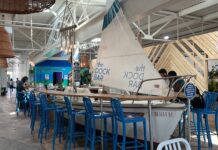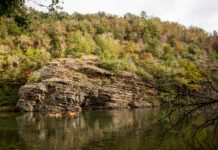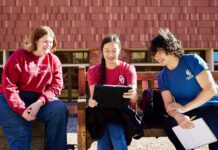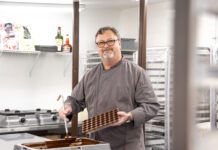For all of the challenges facing the U.S. and Oklahoma in particular, compared to developing countries, and often rural areas in these countries especially, Oklahoma really is “doin’ fine,” as our famous song proclaims.
Many people around the world are less fortunate, and perhaps most Americans aren’t aware of the depth of human struggle overseas until it erupts into a massive humanitarian crisis or international conflict, such as an earthquake or tsunami. The struggle of everyday life for residents of many nations remains outside the ken of many.
There are some Oklahomans, however, who have taken their good fortunes abroad and spent time volunteering in areas where a hand up can mean a huge difference. Some have built such service into their lifestyles, while others are busy sharing their experiences in an effort to recruit the next generation of true good will ambassadors. But to a man – and woman – these Oklahomans have helped make the world just a little bit better for those to whom the easy living and comfort enjoyed in the Sooner State would be paradise.
Seed Sower
Jim Johnson, a soils and crops consultant at Ardmore’s Samuel Roberts Noble Foundation, lives agriculture.
“God, family, friends and agriculture,” he says if you ask him about it.
His passion recently landed him in Iraq on a critical education mission, and the nickname Azad, the Kurdish word for freedom.
The freedom he offered was a wealth of agricultural knowledge in a nation where the people had been too busy fighting wars to grow crops or raise livestock.
Johnson was first involved in helping train National Guard Agricultural Development Teams going to Afghanistan.
“It was inspiring and motivating,” he says. “I thought to myself if I had the opportunity to go and do something similar, I would definitely do it.”
In February 2011, Johnson received an email from Peter Broyles, advisor with the USDA to the Iraqi Minister of Agriculture, with an invitation to assist on an education mission.
Johnson can’t describe the feeling when he stepped out of the airplane in Iraq charged with teaching 15 Kurdish students everything he knows about small grain production.
“They have a lot of book knowledge, but have no real agricultural experience prior to 2003,” Johnson says.
Johnson spent his days teaching students who then work with actual farmers and ranchers, which Johnson says positions them well to share the information.
“They were really excited for me to share my experiences in the real field. I think that was the most valuable to them; to hear and see what other people were doing rather than just read about it in a book.”
Through cultural and language barriers, Johnson worked to teach concepts that would seem very basic to many.
“There were many things that I told them or showed them that were entirely new concepts that they had never heard of or imagined,” he says.
For starters, Johnson had to coach not relying too heavily on their extensive book knowledge. If they used their book knowledge to calculate and apply pesticides for example, it wouldn’t necessarily be economical. He showed them how to calculate the yield of crops that would need protected to break even so they could create a budget.
“You have to adapt and do what works for you. You have to learn how to use what you have and use what you know and make it work for you,” he says.
Oklahomans also have 100 years of testing experience to know what varieties of crops work. Iraqis are screening hundreds of wheat varieties to see what works for them, Johnson says.
Johnson’s students’ hunger for knowledge was unending. Even his time outside of the class was spent engaged in conversation – often two or three at one time. The reward was both personal and professional.
“It’s been a really life changing experience for me,” Johnson says. “Just an amazing experience that I’ll keep with me forever and I’d highly recommend to anyone who gets the chance to do the same.”
Beyond the Hippocratic Oath
Americans might consider doctors’ waiting rooms to be a pain, but Dr. Richard Reinking says that the domestic health care demand can’t compare to that in Tanzania.
“When we set up, hundreds of patients line up to see us every day,” Reinking says.
Reinking is a family physician who practices at the Saint Francis Health System in Tulsa – throughout most of the year, at least. Reinking has been involved with three trips to Tanzania and will be leading a trip this June. The medical mission team from Asbury United Methodist Church of Tulsa usually includes several physicians, a dentist, a pharmacist and sometimes others.
“The sites are set up in the bush, and it really is ‘the bush,’” Reinking says. “We have to travel by very isolated dirt roads to get to the villages.”
But despite the long travel, and sometimes the sicknesses that the medical team experience themselves, Reinking says the experience is humbling and worth it.
“It makes me realize how truly blessed we are in America with material things, but that material things aren’t really what makes you happy,” he says. “It has changed me. I’ve found that I don’t want as much and I don’t buy as much. I’m satisfied with what I have.”
Once set up, the volunteer doctors begin doing what they can for all the villagers who come to see them.
“Everyone that we see gets treated for worms and we give them vitamins,” Reinking says. “We also regularly treat malaria, among lots of other things.”
Reinking tells of experiences that “just break your heart,” such as a mother who could only give her dying baby murky water instead of milk.
“I think that all of us struggle with hearts that harden against people who don’t have anything,” he says. “But these people can’t help where they are born. Maybe I meet the definition of a ‘do-gooder,’ but this is not about me. I try to go to serve and glorify God, and I am part of Asbury as a team.”
Reinking and the Asbury team try to make long-term changes as much as possible.
“As much as possible, we try to promote sustainable healthcare. Those are the solutions,” Reinking says.
Water, Water Not Everywhere
According to the World Health Organization, one in three people on earth is affected by water scarcity. Diarrheal disease caused by water scarcity, like cholera, typhoid fever and dysentery, account for nearly 2 million deaths annually and are the second leading cause of death among children worldwide.
Terri and Dick Greenly are on a mission to right this.
The Greenlys founded Water4 in 2008 to help provide clean water with low-cost materials available locally in areas of the world where people must drink from contaminated sources or travel great distances for potable water. As owners of Edmond-based Pumps of Oklahoma, a wholesale supplier of pumps, the Greenlys were well suited to take up the cause.
The seed was planted after a 2004 trip to China where Dick was invited to install solar water pumps in a remote village.
“We were just a few guys that thought we could do some good in some rural schools in remote south China where little girls could not attend school because there was not water at the schools,” says Dick.
In 2008 the couple created Water4 after Dick traveled to an orphanage in Sierra Leone where the children had been drinking water drawn by hand from a dubious well. After a tank and pump were installed Dick says the orphans who had been suffering from waterborne stomach distress got well.
“After that trip I came back and decided that I really wanted to be doing this,” says Dick.
The Greenlys were passionate about finding a sustainable way for people in challenged areas to have access to water.
“We’re no good coming in to drill one well and getting a photo op. We want the longevity so that they can drill 10, 20 wells a year,” says Dick.
With the help of friend Steve Stewart, they invented a low-tech drilling system and pump made from materials that could be found virtually anywhere in the world.
Then utilizing the same wholesale model their family business runs on, they started finding the best dealers to distribute and install their product, Terri says. These are generally organizations like World Vision who are already on the ground in many of these areas. The organizations serve as the conduit into these communities, Terri says.
Since the inception of the organization Water4 has worked in 30 countries and currently have 14 active projects. One of these is a 1,000- well project in Angola, which is the largest well project on the planet right now, Dick says.
“It is so amazing when water first comes out of that spout,” Terri says.
The reaction from the people?
“There is nothing like it you have ever experienced,” she says.
Water4 is able to give people a water well for $1,000 that would have cost $10,000 with a mechanized rig. This also decreases the amount of time women and children, who are often charged with water collection, spend collecting water by more than 15 hours a week.
Employing the teach-a-man-to-fish philosophy has a tremendous ripple effect. The system in place also provides an economic outlet for the men and women indigenous to these areas who are trained to install the wells.
“There are no jobs so the men have no self-esteem. It’s just like it is anywhere where there are no jobs,” Terri says.
One group of men trained in Uganda named themselves the Young Men’s Drilling Club. A picture of them crouched over a well they have completed showing the finger-etched name of their group in the wet concrete reveals all smiles.
“To see those guys have a job and see those guys happy and excited. It’s more than employment issues,” Terri says. “It is within our power to solve problems in these regions. We have the unique set of drilling tools and this unique hand pump that we’ve come up with. It is well within our ability to do it. And it really motivates.”
Empowering Others
Native Oklahoman Scott Killough says that his volunteer experience began as an adventure, but soon turned into something more.
“When I began what became my ‘career’ in international development work, I didn’t even know it was, or could become, a ‘career’!” Killough says.
After graduating from Oklahoma State University with a degree in agricultural economics and political science, Killough began his work in developing countries by joining the Peace Corps and serving in Guatemala. Through his service, Killough says that he realized he truly enjoyed the work.
“It was satisfying to me to engage with rural people who on the face of things were considered to be ‘poor,’ but whom I saw over time as being very ‘rich’ – in dignity, in strength, in culture, in values,” he says. “And, I think, that realization is what continues to motivate me to work abroad to help people help themselves.”
And that is exactly what Killough is involved in doing today. After considerable experience overseas, Killough is vice president of learning and innovation at World Neighbors.
A nonprofit headquartered in Oklahoma City, World Neighbors is a development organization that emphasizes just that – development – and not tangible relief.
“Our programs aim to build and strengthen local skills and capacities so that, over time, local people gain the knowledge, skills and attitudes to sustain development efforts within their community and beyond,” Killough says. “What struck me most about World Neighbors was the central role that community leaders play in the design, implementation and assessment of rural development projects and activities that meet needs that community people themselves identify as being important to them.”
Through his volunteer and work experiences abroad, Killough says he learned that an opportunity is a powerful incentive for people to make dramatic change in their life.
“Seeing what happens when a person from an isolated area steps up and begins to play a leadership role within one of our programs, and begins to make things happen with their community… it’s very satisfying to see that happen, and to see what results from that process."
Next Generation
As a result of his Peace Corps service, Kye LeBoeuf believes that there is no greater gift than education. And now as a study abroad adviser at the University of Oklahoma, LeBoeuf can spread this lesson. He can also be involved in preparing the next generation of potential Oklahoma volunteers.
It began in 2000 with LeBoeuf’s three-year service in the Republic of Guinea, West Africa.
“The first two years were spent in the rural village of Dogomet located in the forested foothills of Guinea’s Fouta Djallon mountain region,” LeBoeuf says. “There was no running water and no electricity.”
But LeBoeuf describes the region in very positive terms.
“West Africa is a beautiful, friendly and fun place with ancient wisdom, smiling faces and peoples who are open to help from other nations,” he says.
LeBoeuf says that he applied for the Peace Corps in order to fulfill his dream of doing humanitarian work in a Francophone country. He promoted sustainable projects such as composting, live-fencing, mud-stove construction and tree farms.
During his third year, LeBoeuf was a Peace Corps Volunteer Leader in the city of Kankan in the savannah region of Guinea.
“I managed a regional supply and sleep-over house and facilitated communication between volunteers in the field, village and town officials and Peace Corps administrators,” LeBoeuf says.
Throughout his service, LeBoeuf was able to assess the community’s needs and take action. In Dogomet, LeBoeuf focused on reproductive health for at-risk youth, and continued this project during his third year by working with a local doctor to educate youth and midwives.
LeBoeuf believes that his work in reproductive health was his greatest achievement during his time in the Peace Corps, but also emphasizes how much he was affected.
“It can be an amazing, humanizing experience that will allow for years of positive outcomes for the local people served, as well as much personal and professional growth for the volunteer,” LeBoeuf says.
Today, LeBoeuf assists students interested in the regions of Africa, Asia, Latin America and the Middle East, and says that his Peace Corps experience allows him to better prepare students for both in- and out-of-the-classroom experiences.
It is those out of the classroom experiences that have helped shape LeBoeuf – a sentiment reflected in the perspectives of others who have spent time overseas, who have given of themselves, and who have helped alleviate the struggles of needy strangers far from Oklahoma.






















